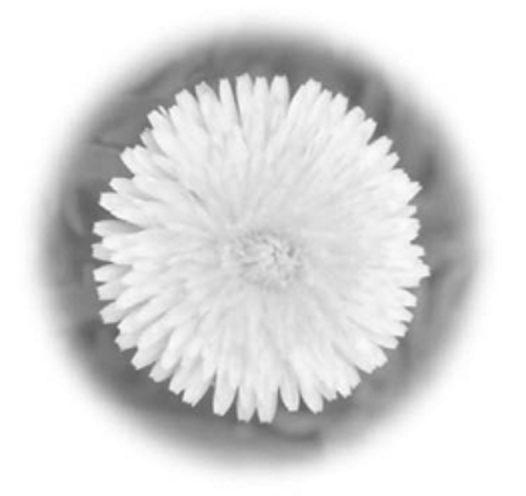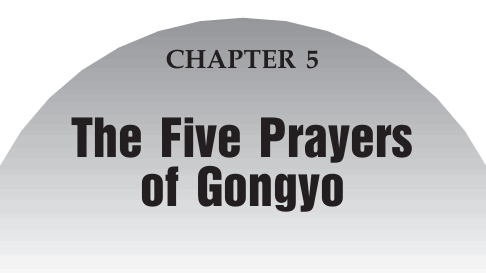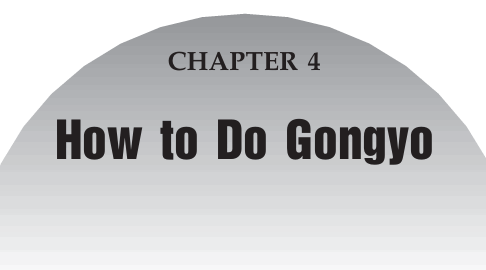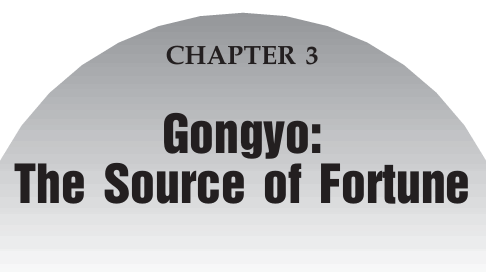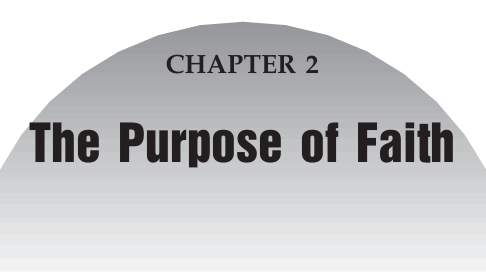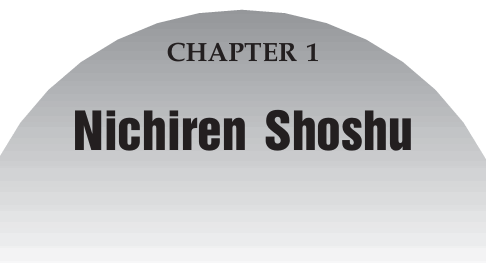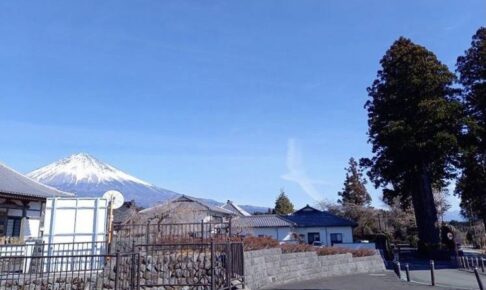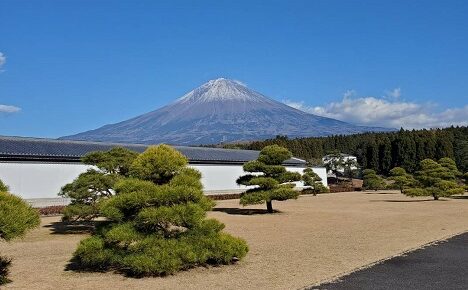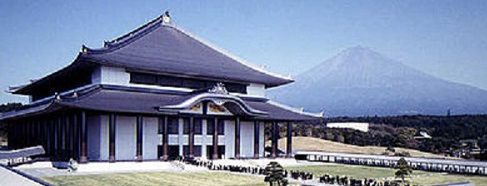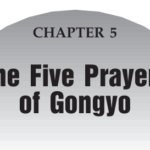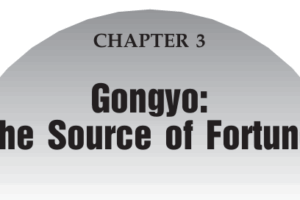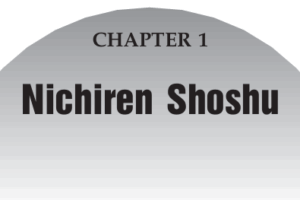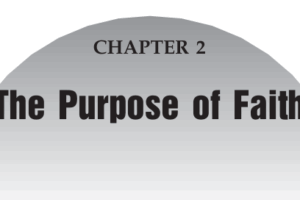Contents
IMPORTANCE OF THE CORRECT OBJECT OF WORSHIP
Honzon is a shortened form of the term “Konpon Songyo” (Konpon: the basis; Songyo: honorable respect). It signifies the object of worship in which one takes faith and reveres as the basis of one’s life.
Generally speaking, each religion has an object of worship in which its teachings, guidelines, and doctrines are embodied. Religions differ because their objects of worship are based on different concepts.
In Buddhism, faith is based on the mystic principle of a mutual interaction between the living beings (believers) and the object of worship. Faith is an act of worshipping the honzon as the basis of one’s belief and object of respect. This then causes the believer to directly receive the teachings presented in that object of worship.
Taking faith in an object of worship is not just based upon emotion, logic, or empirical thinking. Accepting faith gives rise to the effort to unify oneself with the object of worship. Regardless of the degree of superiority or inferiority of the teachings, an object of worship becomes necessary to unite those teachings deeply and directly with the believer’s own life.
One’s happiness or unhappiness is decided conclusively by the object of worship in which one believes. If one worships an incorrect object, one’s life condition declines, causing suffering and eventual stagnation. The most important thing is to choose the correct object of worship.
Many people think all religions are good, saying “Faith moves mountains.” But the crucial point is what to base that faith upon. There is a great difference, for example, between worshipping a socalled transcendental being and the teachings of a worldly philosopher. If we make a mistake in the choice of our object of worship, it will result in undesirable effects. Therefore, in the Gosho, the True Buddha, Nichiren Daishonin tells us to “choose the most superior object of worship.”
(Gosho, p.1275).
The correct religion that will truly benefit the people is the one that holds the supreme, true object of worship.
THE THREE VIRTUES AND THE ONENESS OF THE PERSON AND THE LAW
The Dai-Gohonzon that Nichiren Daishonin inscribed in the form of a mandala is the life of the True Buddha Himself, possessing the Three Virtues of Sovereign, Teacher and Parent.
1. The Sovereign, with absolute power, works to protect all the people.
2. The Teacher instructs and guides all people so they may attain enlightenment, the state of absolute happiness.
3. The Parent manifests the compassion and mercy to nurture and support all living beings. The Gosho states:
The Buddha is the lord of those in the worlds of Humanity (Nin) and Heaven (Ten), the parent of all the people, and the teacher who enlightens them. A parent with lowly virtues lacks the virtues of a Lord. Lords are to be feared unless they possess the compassion of parents. Even if some are both parent and lord they are not necessarily teachers. All Buddhas who are respected are lords but since they did not appear in this world, they are not teachers.
(Gosho, p. 628).
The Gohonzon possesses all Three Virtues, and is the only True Object of Worship that can save all people from the sufferings of birth and death. It is important for us to be attentive to our attitude and posture in front of the Gohonzon. We must recite the Sutra and chant Daimoku with sincere devotion. Then, enlightenment is possible, bringing the Buddha nature embodied in the Gohonzon and one’s own nature into oneness.
The Gohonzon is the manifestation of the oneness of the Person and the Law. Even though the most superior Law exists in the universe, it is impossible to prove its existence without the Person (Buddha) who is enlightened to it. On the other hand, if a Buddha did not possess the enlightened wisdom to realize the Mystic Law he would be only a common mortal. Nichiren Daishonin is the only one who is eternally enlightened to the True Law which can lead everyone to Buddhahood. He inscribed His enlightened life in the form of the Great Mandala, the DaiGohonzon. The Dai-Gohonzon embodies Nam-Myoho-RengeKyo of actual ichinen sanzen (the Law) and the eternally enlightened life of the True Buddha, Nichiren Daishonin (the Person) which are, together, the entity of the oneness of the Person and the Law (ninpo ikka).
Nichiren Daishonin states in the Gosho:
This Law embodies ichinen sanzen, the life of the Buddha; even the most intelligent scholar in the world cannot comprehend the Law.
(Gosho, p. 523).
Even if we don’t understand the whole concept of the Law, it is, in fact, the life of the Buddha, Nichiren Daishonin. We must face the Gohonzon as if we were facing the living Nichiren Daishonin. Through various experiences and study of the True Teaching, we will become convinced that the Gohonzon is the living Buddha.
HOW TO SET UP YOUR NICHIREN SHOSHU ALTAR
Offerings to and Care of the Gohonzon
Our basic spirit toward the Gohonzon should be one of great respect. If we have the fundamental attitude that the Gohonzon is the living Buddha, endowed with the Three Virtues of Sovereign, Teacher and Parent, then we will always treat the Gohonzon with the greatest respect.
The Gosho, “On Attaining Buddhahood” states:
Whether you chant the Buddha’s name, recite the sutra, or merely offer flowers and incense, all your virtuous acts will implant benefits and good fortune in your life. With this conviction you should put your faith into practice.
(MW, Vol. 1, p. 4; Gosho, p. 46)
To recite Gongyo and to chant Daimoku to the Gohonzon are the basic practices of this Buddhism. You do Gongyo to perfect your life. It should not be done out of a sense of formality. An attitude of appreciation and gratitude is most appropriate.
It is important to understand that the Gohonzon is loaned to you by the Head Temple. When you receive the Gohonzon at the Nichiren Shoshu Temple, open a brand new sutra book and hold it above eye level. The Priest will place the Gohonzon on it. The Gohonzon is rolled up in a special envelope. When you return to your seat, carefully cover the envelope with the Gohonzon inside with a fukusa (scarf).
The Gohonzon embodies the very life of Nichiren Daishonin; hence it should be treated with the utmost respect and sincerity. Until the Gohonzon is enshrined, pay close attention not to harm or damage it. It should not be unwrapped until it is enshrined in your home by an experienced member (preferably two). The enshrinement ceremony should take place as soon as possible.
For newer members, when changing residence, do not handle the Gohonzon alone. Always have an experienced member assistThe Gohonzon 39 you until you have learned the proper procedure for the enshrinement ceremony.
When deciding where to place your altar, the most important thing is to consider the most suitable place for the Gohonzon. The Gohonzon is endowed with the Three Virtues of Parent, Teacher, and Sovereign which will lead you to absolute happiness; therefore, it should be treated with the utmost respect and sincerity. Even in a one-room apartment, it should be placed in the best possible area.
You should use a proper altar made specifically for that purpose, called a Butsudan. It should be sturdy, clean, and secure. If the Butsudan has no doors, a cloth can be draped across the front, which then can be opened and closed.
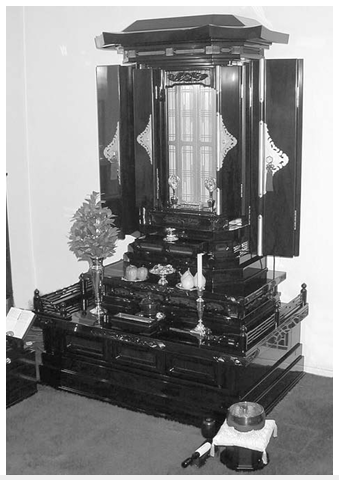
The Gohonzon should not be placed too high or too low. When you sit or kneel in front of your Butsudan, the bottom of the Gohonzon should be slightly above eye level. Never place things on top of the Butsudan, have shelves surrounding it, or pictures and other articles on the wall with the Butsudan.
There is no substitute for the Gohonzon. Therefore, doing these things should be based on your sincere faith and not out of formality. The Gohonzon is supreme and your actions in the handling and care of the Gohonzon should reflect that understanding and your sincere faith.
At the front of the Butsudan should be a space to place the offerings. The offering closest to the front of the Butsudan is water in a water cup. Place fresh water in a cup in front of the Gohonzon first thing in the morning before anyone uses water in the house. First run the faucet to flush out the still water so that you can offer the Gohonzon clean, cool water. Leave the water for the remainder of the day and then remove the cup and empty out the water before Evening Gongyo. You have a choice of putting the empty cup away until the morning when you offer water for that day, or you can place the empty cup at the front of the Butsudan. If you have a water cup with a lid, the lid should always be removed when the cup is offered to the Gohonzon with water in it. If, after emptying the cup before Evening Gongyo, you replace the empty cup in front of the Butsudan, it should be covered with the lid.
As you face the Butsudan, on the right, place a candle holder with a white candle; on the left, place evergreens in a vase; and in the middle, place the incense burner. These three items together are called mitsugusoku (three accessories). This is an extremely important formality (Kegi) in the practice of this Buddhism. Sometimes gogusoku (five accessories) are used: incense burner in the center, a pair of candles, one on either side, and two vases with evergreens placed to the outside of each candlestick. Incense, candles and evergreens, each have a significant meaning in Buddhism.
Incense represents the Property of the Law or the essential property of the Buddha’s life. This is the truth to which the Buddha is enlightened.
Candles represent the Property of Wisdom or the spiritual property of the Buddha’s life. This enables the Buddha to see the truth.
Evergreens represent the physical property of the Buddha’s life, the Property of Compassionate Action.
The incense, candles and evergreens should be placed in a straight line. There is special significance to this. In Nichiren Shoshu, we revere the True Buddha, Nichiren Daishonin as the True Buddha who possesses the Three Enlightened Properties and whose Three Enlightened Properties comprise His single being. This profound concept teaches, in very simple terms, that the Property of the Law (signified by the incense), the Property of Wisdom (signified by the candles), and the Property of Action (signified by the evergreens) are inseparable and totally integrated as the life of the True Buddha. Incense is made from fragrant wood like shikimi, an evergreen. Therefore, the flame from the candles and the shikimi (evergreen) come together and as a result you get smoke from the incense. The Property of Wisdom (candles) and the Property of Action (shikimi) combined are the Property of the Buddha (incense). The candles, evergreens, and incense are in a straight line, to demonstrate that significance in front of the Gohonzon.

In society, we often use cut flowers to express love or respect, or for decoration. They are beautiful to look at, but flowers die in a few days. From the standpoint of Buddhism, cut flowers are improper offerings to the Buddha because of their ephemeral nature. Evergreens, on the other hand, will last a long time if you change the water in the vase(s) every day.
We usually burn three sticks of incense, but if too much smoke is produced we may use fewer. The three sticks of incense represent the Three Treasures—the Treasure of the Buddha, Treasure of the Law, and the Treasure of the Priesthood. The Treasure of the Buddha is Nichiren Daishonin. The Treasure of the Law is the DaiGohonzon. The Treasure of the Priesthood is Nikko Shonin and the successive High Priests.
When we use incense sticks for secular purposes, we usually burn them in an upright position. In Nichiren Shoshu they are laid down. The significance behind this is that when the incense is standing upright, the ashes fall and scatter. The scattered ashes signify a scattered mind. When the incense is laid down, the ashes do not scatter. It also purifies the area in front of the altar and is an offering to the Gohonzon.
The Gohonzon embodies the life of Nichiren Daishonin and the altar is the Buddha’s home. The area where the Gohonzon is enshrined is always kept clean. When cleaning the Butsudan area, or Butsudan accessories, an evergreen leaf or a piece of white paper should be kept between your lips as a gesture of respect. Take care to use a clean cloth or duster.
If you eat rice, you may offer it to the Gohonzon. Do not place uncooked rice on the altar. This, unlike water, should not be left all day. After the rice is cooked, the first portion should be offered to the Gohonzon. Ring the bell three times and, observe this silent prayer:
“I offer deepest gratitude to the Three Treasures of the Buddhism of Sowing. Nam-Myoho-Renge-Kyo.” (Namu geshu sampo goho on shatoku Gokuyo no tame. Nam-MyohoRenge-Kyo.)
Chant Daimoku three times, then remove the rice. Ringing the bell three times signifies appreciation for the Three Treasures.
You may also offer other kinds of food to the Gohonzon. Food offerings, if possible, should be placed in front of the Gohonzon in the space between the water cup and the lined up incense, candles and evergreens. All food offerings must be vegetarian, and traditionally we avoid offering odoriferous foods such as onions, or garlic. When making offerings to the Gohonzon, ring the bell three times and chant Daimoku three times.
These are the basic offerings to the Gohonzon. The most important thing to understand is that the Gohonzon is the living Buddha.
The doors of the Butsudan should be opened when chanting. Otherwise they should be kept closed in order to protect the Gohonzon. In the event of a fire or natural disaster, protect the Gohonzon first.
Lastly, when entering or leaving a home where there is a Gohonzon, always do Daimoku Sansho (chant Nam-Myoho-RengeKyo three times), offering a greeting to the Gohonzon.
INSTRUCTIONS FOR ENSHRINING THE GOHONZON
Please do not open the envelope and unroll the Gohonzon after the Gojukai ceremony. You should wrap the envelope with a clean cloth or scarf (fukusa) and safely place it in a case or bag you brought for that purpose. When you carry the Gohonzon in a case or bag, please be careful to protect it from being buffeted about. Keep the Gohonzon in the envelope it came in until it is ready to be properly enshrined by your sponsor.
The ceremony to welcome the Gohonzon into your home signifies gaining the source to lead the most fulfilled life, founded upon faith. It is an important and solemn ceremony in which you receive into your home the most noble and dignified True Buddha who will correctly guide your life. What follows are the important things to remember for the Gohonzon enshrinement ceremony and the handling and care of the Gohonzon.
Preparation
The Gohonzon should be enshrined in the most respectable room of the house. If you have a multi-story or split level home, you can enshrine it on any level as long as the location is respectful. The important thing, however, is to consider the most suitable place for the Gohonzon. Places with heavy foot traffic that stirs up dust or those too near distracting noises should be avoided. It is a good idea to discuss this with your sponsor.
Before the Gohonzon enshrinement ceremony, again with your sponsor’s advice, you must prepare a Buddhist altar (butsudan) and various Buddhist accessories (butsugu) such as an incense burner, vase(s) for evergreens, candle holder(s), a water cup, a bell and bell striker. Buddhist accessories should include either the three-piece set of one incense burner, one vase and one candle holder (mitsugusoku); or the five-piece set of one incense burner, two vases and two candle holders (gogusoku). The room should be cleaned beforehand.
Ideally, a Buddhist altar is positioned so that the Gohonzon is facing south. This, however, is only a suggestion; if the floor plan or the arrangement of the room does not allow you to place the altar in this fashion, you can be flexible. In some cases the altar may be on the west wall, and you would have to turn your back to the Gohonzon when reciting the first prayer in Morning Gongyo. To avoid turning your back completely to the Gohonzon in such instances, you should turn slightly off line from the Gohonzon during the first prayer. If the altar is on the east wall and you cannot do the first prayer without directly facing the Gohonzon, again you should seat yourself slightly off line.
Ceremony
After all the necessary preparations are made, you can proceed with the enshrinement ceremony itself. The leader should wash his or her hands in advance. First everyone should start chanting Daimoku.
The leader then places an evergreen leaf or a piece of white paper between his or her lips. Next, the leader should take away any accessories that may interfere with enshrinement and put them on a separate table.
While those in attendance chant Daimoku, the leader unwraps the cloth and very carefully removes the Gohonzon from the envelope.
If the Gohonzon is hanging too high in the butsudan, then the attached long string can be used to tie a loop from which to hang it. Then, while holding the bottom wood dowel, the leader unrolls the Gohonzon very slowly, letting the weight of the wood help it unroll naturally.
The Gohonzon should be handled very gently with the utmost care and with the lightest touch. Even the rolled Gohonzon can be wrinkled if it is handled too roughly. Even though it may take more time to do the enshrinement, please handle the Gohonzon carefully. You can touch the brown frame part of the Gohonzon if necessary, but please never touch the white part of the Gohonzon with the inscription of the Chinese characters. Also, never breathe on the Gohonzon. After it is enshrined, you may notice that the bottom of the Gohonzon curls upward. In most cases this is nothing to be concerned about. In time, it will straighten out on its own from the weight of the wood. However, if the curl is too high, you may very gently roll the bottom wooden dowel up the back of the bottom of the Gohonzon and roll it back down to reduce the curl. Be very careful not to roll it up to the white part with the inscription of the Chinese characters.
Generally speaking, the Gohonzon should be higher than eye level. If the Gohonzon hangs too high, you can adjust the level by using the string. You can also adjust the height of the altar. If you wish to adjust the height of the altar, however, you are encouraged to do so in advance. Please do not move the altar once the Gohonzon is enshrined. Also, please avoid enshrining the Gohonzon so low that you would be looking down at it while chanting.
After the enshrinement is completed, the leader bows deeply to the Gohonzon with palms together in reverence, then places the Buddhist accessories in their proper positions. Sufficient distance should be maintained between the Gohonzon and the Buddhist accessories to avoid any damage to the Gohonzon in the event of an accident.
Next, the leader and all participants begin the recitation of the sutra. The Hoben and Juryo chapters (Parts A, B, and C) are recited once, followed by Daimoku. After concluding the chanting of Daimoku, the following silent prayers are read: the second, the third, and the second portions of both the fourth and fifth prayers. In the second part of the fourth prayer, it is recommended that you pray to deepen your faith, to expiate negative karma created by the slander of the Law, that each successive generation of your family will be able to carry on the practice of faith in the Mystic Law eternally, for the peace and prosperity of your family, and for the achievement of world peace through the propagation of True Buddhism. After reading the silent prayers, the ceremony will be concluded by chanting Daimoku three times. In order to avoid splattering wax, please use a candle snuffer to extinguish the candles instead of blowing them out or fanning them with the hand. In most cases it is best not to conduct either Morning or Evening Gongyo during the enshrinement. This is a separate, solemn ceremony.
Since the Gohonzon is made of wood and paper, after many years it may become discolored or otherwise marred. We must, however, try to prevent this as best we can. We must make every effort to keep the Gohonzon in good condition for as long as possible. For example, we should be careful not to splash wax or water on the Gohonzon. We should never handle the Gohonzon unnecessarily. We should also exercise precautions to prevent any accidents caused by children or pets. The Gohonzon should not be exposed to direct sunlight. As mentioned earlier, unless you are conducting Gongyo or chanting Daimoku, the doors of the altar should be closed to protect the Gohonzon.
The Gohonzon is the very life of the True Buddha, Nichiren Daishonin. Please treat it with the deepest reverence and respect. Never photograph the Gohonzon or allow it to be videotaped. If you have any question about the care of the Gohonzon, please do not hesitate to call your local Nichiren Shoshu Temple. If your Gohonzon is accidentally damaged, or if you would like to have the dust cleaned off the Gohonzon, please contact the Chief Priest of your local Temple.
